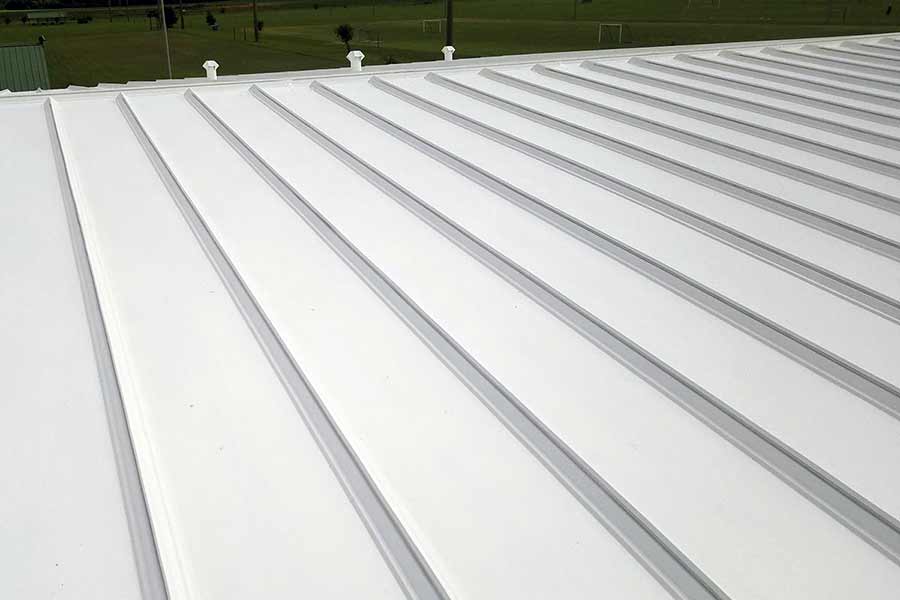The realm of metal roofing is vast and varied, encompassing many styles that can accommodate virtually any architectural vision or functional requirement. Each style offers unique aesthetic appeal and specific durability, maintenance, and installation benefits. Let’s explore these options in greater depth.
Standing Seam Metal Roofs
Standing seam metal roofs are distinguished by their raised seams that extend vertically along the roof’s length, well above the level of the roofing panel. This design significantly enhances leak resistance by minimizing the number of seams exposed to the elements. Additionally, the hidden fastener system used in standing seam roofs eliminates the risk of water infiltration through screw holes, making it an excellent choice for regions prone to heavy rain or snow over other metal roof types. Available in various materials, including aluminum, steel, and copper, standing seam metal roofs offer a sleek, contemporary look while providing exceptional durability and performance.
Metal Shingles and Tiles
Metal shingles and tiles replicate the appearance of traditional roofing materials such as wood shakes, slate, or clay tiles, combining classic aesthetics with the inherent advantages of metal. This option allows building owners to achieve the desired look without compromising longevity or resistance to fire, wind, and impact. Metal shingles are lightweight, making them suitable for a wide range of structures, and they come in numerous colors and textures to fit any architectural style. Furthermore, they provide an energy-efficient roofing solution, reflecting solar radiant heat and reducing cooling costs.
- Galvanized Steel is coated with zinc to protect against rust. It’s a popular choice for its balance of durability and cost-effectiveness, and it is ideal for a wide range of commercial buildings.
- Galvalume Steel combines zinc and aluminum coating to offer enhanced corrosion resistance. It is particularly suitable for areas with a mix of wet and dry conditions.
- Weathering Steel (Corten) is designed to develop a stable rust-like appearance when exposed to the weather, protecting against further corrosion. It’s best used in architectural applications where the rustic appearance is desired and can be allowed to weather naturally.
Corrugated Metal Roofs
Corrugated metal roofing, with its characteristic rippled surface, is known for its strength and durability. The corrugation process increases the tensile strength of the metal, enabling it to withstand heavy loads and severe weather conditions. This type of roofing is highly cost-effective, offering a long lifespan with minimal maintenance requirements. Corrugated metal roofs are versatile enough to suit modern and traditional commercial buildings, providing a practical yet aesthetically pleasing roofing solution.
Ribbed Metal Panels
Ribbed metal panels feature a series of high ridges and low valleys, creating a pattern that adds texture and dimension to the roof’s surface. Similar to corrugated metal but with a more pronounced profile, these panels are available in exposed and concealed fastener configurations. Ribbed metal panels can be used in various applications, from commercial and industrial buildings to agricultural structures. They offer excellent durability, weather resistance, and the added benefit of quick and easy installation.
Architectural and Structural Metal Panel Systems
Architectural metal panel systems are designed for visually demanding applications where aesthetic appeal is as important as performance. These panels offer a smooth, modern façade and are available in various finishes and materials, including aluminum composite materials (ACM) and coated metals. On the other hand, structural metal panels are engineered to provide load-bearing capabilities and serve as a weather-tight roof or wall covering. Both systems allow creative design flexibility, enabling architects and builders to realize distinctive and innovative building envelopes.
Exposed Fastener Panels vs. Concealed Fastener Panels
The choice between exposed and concealed fastener panels hinges on aesthetic preferences and performance requirements. Exposed fastener systems are more traditional and cost-effective, making them popular for industrial and commercial applications over other metal roof types. However, concealed fastener panels are preferred for a cleaner look and enhanced weather resistance. These systems hide the fasteners from view, creating a smooth, uninterrupted surface that elevates the building’s overall aesthetic while minimizing the potential for leaks.











